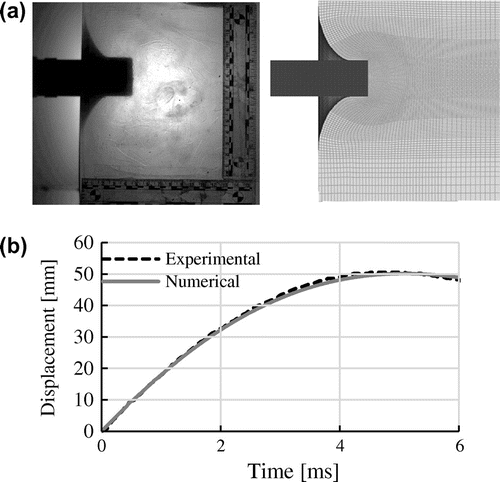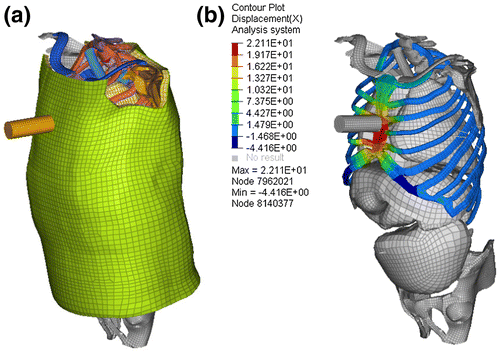1. Introduction
Over the past decade, numerous studies have been undertaken to understand the human body response during blunt ballistic impact. Indeed, non-penetrating ballistic trauma can occur during the use of Less-Lethal Kinetic Energy projectiles (LLKE). A study about rigid LLKE projectile impacts on Post Mortem Human Subjects (PMHS) has been carried out (Bir et al. Citation2004). It leads to the development of biomechanical response corridors and the use of the injury criterion VCmax to establish the probability of skeletal injury (Bir and Viano Citation2004). Therefore, the French Ministry of the Interior and the authors develop a methodology with a coupled experimental-numerical based approach to assess blunt trauma. Among various backing materials employed as human body substitutes, the polymer gel SEBS (styrene-ethylene-butylene-styrene) has been identified as an appropriate ballistic gelatin susbtitute (Mauzac et al. Citation2010). Although gel transparency allows direct impact analysis using high-speed camera and provides information such as the dynamical wall displacement, the volume of deformation, these data are not sufficient to establish a direct link towards blunt ballistic trauma. Hence, the authors focus their research on the use of numerical tools as finite element (FE) model. Extend information can be obtained such as, strain, strain rate and pressure. In addition, the human torso FE model called HUByx is used in this study and has shown its biofidelic ability to replicate high-speed loading accidents (Roth et al. Citation2013). The robustness of numerical tools may lead to the correlation of predicted results with the experimental work and the investigation of case reports. The aim of this work is to introduce a reliable method and first results based on experimental and numerical study for ballistic trauma assessment.
2. Methods
Firstly, the impact conditions of Bir reference cases, performed on the mid-sternum of PMHS, are replicated on the SEBS gel block of 25 × 25 × 25 cm size (Bir et al. Citation2004). The test consists in the impact of round rigid projectile of 140 g with 37 mm in diameter at 20 m/s (projectile velocity in case reports). A challenge is to correlate numerical impact with experimental one. An incompressible hyperelastic Mooney-Rivlin material model is employed and material constants are determined using an optimization by inverse method (Rivlin Citation1948). The impact model is built using the commercial explicit FE code Radioss (Altair Hyperworks). 52,480 hexahedral elements represent a quarter of the gel block using planes of symmetry. Concerning the material constants identification, experimental wall displacement data are used as objectives to reach in the multi-objective optimization process using global response surface method. Secondly, the same impact condition is reproduced on the HUByx torso model using Radioss. This complex model consists in the average representation of the human thorax/abdomen/pelvis system including the main organs: heart, lungs, kidneys, liver, spleen, the skeleton, stomach, intestines, muscles and skin.
3. Results and discussion
On the one hand, Figure illustrates qualitative comparison of experimental impact ((a)-left) of 140 g projectile at 20 m/s on the gel block and numerical modeling ((a)-right). Moreover, the excellent match between experimental and numerical wall displacement (Figure (b)) leads the authors to establish the efficiency of the material model. The two Mooney-Rivlin parameters C10 and C01 are respectively equal to 0.0299 and 0.0776 MPa. Once numerical model is valid, deeper investigations can be lead on the pressure, strain and strain rate field. On the other hand, the same impact condition has been reproduced on the HUByx torso model. Figure (a) presents the global model with the round projectile, the human model and Figure (b) the maximum displacement field of the skeletal system with an impact occurring directly to the mid-sternum. This information is introduced because the thoracic wall displacement is used to determine the VCmax. Referring to the curve of the probability of AIS 2 or 3 in function of the VCmax determined by logistic regression analysis from experimental cadaver data, the VCmax predicted value with HUByx equal to 0.36 m/s is equivalent to a probability of 10% to obtain an AIS of 2 or 3 (Bir and Viano Citation2004). This result is highly consistent with the experimental work on cadavers. The HUByx model may provide supplementary data as strain, pressure field not only for skeleton parts but also for each major internal organ such as, lungs, the heart, the liver, the spleen. In addition, the skeleton, is constituted of many elements like the sternum, the costal cartilage, ribs. It represents a multitude of data to process and a statistical approach will be necessary to find a correlation between experimental and numerical data. For example, the use of a correlation matrix is a highly relevant tool to establish a transfer function between experimental data and a probability of blunt trauma using numerical modeling.
4. Conclusions
The complex nature of human body and impact conditions lead the authors to develop a robust method to assess the risk of blunt trauma based on experimental and numerical approaches. Experimental impact on cadavers is reproduced on gel block and is modeled using FE method. Mooney-Rivlin material model is highly efficient to represent experimental impact on gel at a given impact velocity. For distinct impact conditions, a more elaborate material model taking into account the strain rate dependence will be necessary. Moreover, the human FE model HUByx appears to be a satisfactory representation of human body based on replications of high-speed impact. Therefore, a direct correlation between numerical FE model data and the risk of skeletal injury is expected based on the work of Bir. However, to go further on this path, statistical approach will be imperative to find a suitable transfer function between experimental data on the gel block and the risk of blunt trauma.
Acknowledgements
This research is funded by the French Ministry of the Interior and is carried out within the framework of the CNRS Research Federation on Ground Transports and Mobility, in articulation with the ELSAT2020 project supported by the European Community, the French Ministry of Higher Education and Research, the Hauts de France Regional Council, The AIP-Priméca Nord-Pas de Calais group. The authors gratefully acknowledge the support of these institutions.
References
- Bir C, Viano DC. 2004. Design and injury assessment criteria for blunt ballistic impacts. J Trauma Inj Infect Crit Care. 57:1218–1224.
- Bir C, Viano D, King A. 2004. Development of biomechanical response corridors of the thorax to blunt ballistic impacts. J Biomech. 37:73–79.10.1016/S0021-9290(03)00238-0
- Mauzac O, Paquier C, Debord E, Jacquet JF. 2010. A substitute of gelatin for the measurement of dynamic back face deformation. Personal Armour System Symposium, Canada.
- Rivlin RS. 1948. Large elastic deformations of isotropic materials. IV. Further developments of the general theory. Philos Trans R Soc Math Phys Eng Sci. 241:379–397.10.1098/rsta.1948.0024
- Roth S, Torres F, Feuerstein P, Thoral-Pierre K. 2013. Anthropometric dependence of the response of a Thorax FE model under high speed loading: Validation and real world accident replication. Comput Methods Programs Biomed. 110:160–170.10.1016/j.cmpb.2012.11.004


